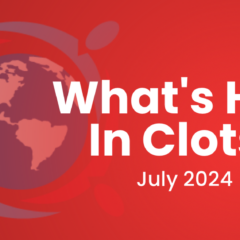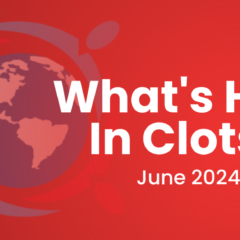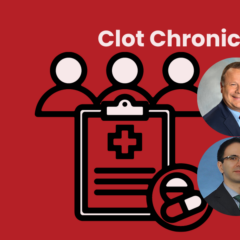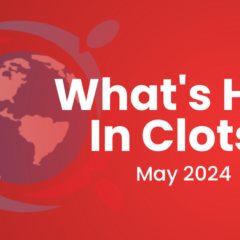Last updated on
Clot Chronicles: Special Edition — Takeaways from ESC 2020
Hi, pleasure to speak with you today on Clot Chronicles for NATF. I’m Dr. Christian Ruff, director of general cardiology at Brigham and Women’s Hospital and Harvard Medical School and a board member at NATF.
We’ve just had a very exciting European Society of Cardiology 2020. Of course, it was virtual in the era of COVID, but that didn’t stop a lot of groundbreaking, exciting science that was presented over the past several days. Probably the biggest blockbusters of the ESC were regarding the SGLT2 inhibitors, which we know were developed for treatment of diabetes but have really emerged as drugs that we can use in an armamentarium to reduce heart failure and kidney events.
And there were two trials presented, the EMPEROR-Reduced with empagliflozin, which confirms what we saw with dapagliflozin and DAPA-HF, that these drugs—regardless of whether you have diabetes—substantially reduced heart failure (HF) and hospitalization in patients with heart failure with reduced ejection fraction (HFrEF). And they actually improved renal function as well (prevented the decline in glomerular filtration rate). So, these drugs are really cemented, I think, in our treatment of HFrEF regardless of whether those patients have diabetes.
Another thing that emerged in the DAPA-CKD study, which was with the SGLT2 inhibitor dapagliflozin, is that these drugs are very effective in patients with chronic kidney disease (CKD), regardless of whether they have diabetes or heart failure. This was a trial that on top of ACE inhibitors and angiotensin receptor blockers these drugs substantially reduced kidney failure or progression of renal disease and actually prolonged survival in patients with CKD. So, we really need to think about these drugs in terms of organ protection. Yes, they’re diabetes drugs, they help manage glucose, but they have substantial cardiovascular (CV) benefit in patients with and without diabetes, particularly in patients with HFrEF and CKD.
Now, particularly relevant for our interest in thrombosis, there were very exciting results in the field of atrial fibrillation (AFib). One prominent study, EAST-AFNET 4, was looking at an early rhythm-control strategy in patients with AFib. It was a very large study, a little less than 4,000 patients, looking at upfront antiarrhythmic management with either drugs or catheter ablation. It somewhat surprisingly showed that early intervention with structured follow-up significantly reduced CV events, particularly CV death and stroke. So, kind of rechanging our thoughts about how we should manage patients when they present with AFib and suggesting that, at least in a subset of patients, if we’re more aggressive with rhythm control, whether that’s with drugs or catheter ablation, that we may actually improve CV outcomes. So again, a very exciting study that certainly needs further follow-up.
Now, of course, the other part of management of AFib is around anticoagulation, and that’s irrespective of whether you do a rate- or rhythm-control strategy. And there was an interesting study, IMPACT-AFib—a very large study, over 47,000 AFib patients—and it looked at a targeted intervention where these patients received a single educational mailing. And unfortunately, it didn’t affect oral anticoagulation rates, but there was a numeric increase that didn’t reach statistical significance. I think the take-home from this trial is that perhaps a single educational intervention isn’t enough. There was a small signal of an increase numerically, at least, in anticoagulation rates but perhaps a more aggressive intervention with multiple mailing/multiple contacts with a patient is needed to improve anticoagulation rates.
Of course, our sister to AFib and arterial thrombosis is venous thromboembolism (VTE), and there were very interesting results from the HOME-PE trial, which really looked at risk stratification in the emergency department (ED). So, in patients who presented to an ED with pulmonary embolism (PE), using either 2 risk stratification tools—whether that’s the HESTIA or simplified PESI score—you could identify a third of patients who had low-risk PE who could be safely managed at home. I think that’s very interesting. In the United States, we obviously admit many PE patients. But using simple risk stratification in this European study, we really could identify a third of PE patients who probably could be safely managed outside of the hospital.
On the coronary front, there was some illuminating data about colchicine, which has really been in the news over the past year. The LoDoCo2 trial showed that colchicine improved CV outcomes—particularly myocardial infarction (MI) and revascularization—in patients with chronic coronary disease. And this is really a follow-on to some of the exciting results from the prior COLCOT study. I will say in this LoDoCo trial, there was a trend to more non-CV death, not statistically significant but a trend. And actually, there was another study at the ESC, the COPS trial, which was a smaller study in acute coronary syndrome (ACS) that showed a similar benefit in revascularization but actually a statistically significant excess in non-CV mortality. So, I do think there are some things to work out. Colchicine may be effective, particularly for MI and revascularization, but there may be this non-CV mortality signal that needs further investigation.
There were also three updates to the European Society of Cardiology guidelines; the first update in AFib gives some additional granularity to screening for AFib, which I think is important. The European guidelines now mention opportunistic screening for all patients that are 65 years or older. What is opportunistic screening? Checking a pulse if it’s irregular, getting an electrocardiogram, and for high-risk patients who are very likely to have AFib—those 75 or older at high risk of stroke—even systematic ECG screening to capture AFib before those patients have a stroke.
There was a lot more language and guidance around structured characterization, not just anticoagulation but symptom management, rate and rhythm control, sort of a holistic approach with cardiologists, nurses, general practitioners, and pharmacists, and I think that’s certainly a direction that we should all be going in. Some further commentary on bleeding risk scores mention that the HAS-BLED score is a good bleeding risk score to identify modifiable risk factors that may need closer follow-up but should not be used as a risk score to deny anticoagulation to the patients who meet a guideline indication. And probably the most important guidance was around what to do in patients who have concomitant AFib and either elective PCI or ACS. We now have at least 4 trials informing our decision regarding this.
Novel oral anticoagulants (NOACs) should be used preferentially; they have a lower bleeding risk than vitamin K antagonists. And we probably should limit triple therapy in most situations to a week, at most, a week or less and only really in select patients who have a very high risk of stent thrombosis would we consider triple therapy for up to a month. And then we would use dual therapy, a P2Y12 inhibitor, plus the anticoagulant for up to one year and then probably just an anticoagulant alone, which both reduces the risk of stroke as well as secondary coronary events.
There was also some further information regarding catheter ablation. Certainly, in patients with symptomatic HFrEF, catheter ablation reduces HF outcomes – but we probably don’t have strong data at this time in patients with AFib and normal left ventricular function whether catheter ablation improves outcomes.
I think an important thing to end on with AFib is that we really can’t forget about risk factor modification. Obesity and obstructive sleep apnea are big drivers of AFib, they’re big drivers of burden of AFib, so a structured weight loss program and treatment of sleep apnea are essential if you want to manage or prevent AFib.
There was the non-ST elevation guidelines at the ESC as well. They gave some similar guidance regarding triple therapy in patients with AFib and ACS around really limiting triple therapy to a week or, at most, a month. The guideline gave further granularity in that high-sensitivity troponin really is the assay that we should be using to diagnose non-ST elevation myocardial infarction (NSTEMI). I think the most important guidance was really about the rule-out strategies. High-sensitivity troponin is so sensitive we could really tighten the rule-out window and using only two troponin assessments either at zero and one hour or zero and two hours, and that can identify patients who are negative at the 1- or 2-hour assessment who can be safely discharged from the hospital. So, I think that’s very important when we evaluate chest pain in the ED.
There’s also some further information we’ve gotten from trials that patients with high-risk NSTEMI—those with very high high-sensitivity troponin and an elevated GRACE risk score—that those patients probably benefit from an early routine invasive approach, maybe within 24 hours of admission. And obviously, for patients with less high-risk NSTEMI, that can extend to 48-72 hours. And I think that there was also important information regarding how long we continue dual antiplatelet therapy (DAPT) in these patients: clearly patients with ACS if they’re at continued risk of thrombosis for 12 months, irrespective of whether they’ve had a bare-metal or drug-eluting stent. But certainly recognizing that there have been different trials with shortened duration DAPT—less than 12 months or extended-duration DAPT fore more than 12 months—and the need for a more personalized approach for those situations.
I’d like to end on an interesting guideline about sports cardiology and exercise, and this is really a comprehensive and well-organized document that gives guidance about CV risk and screening for exercise, particularly in patients who have CV conditions. It highlights that sudden cardiac death (SCD) is really the leading cause of exercise-associated mortality, so something we should all be familiar with. And certainly, in athletes greater than 35, the majority of SCD events are attributed to coronary disease. So, I think whether a patient with CV disease is participating in recreational or competitive athletics, they really should undergo formal evaluation, which should likely include a stress test.
But, patients with CV disease should exercise, and the guidelines say on most days, 150 minutes per week of at least moderate exercise. So, I think that that’s an important message, that yes, you should have some risk stratification, but we should be encouraging exercise in all of these patients. And particularly in patients with HF, again, exercise is very important. These patients probably should undergo a maximal exercise stress test and a cardiopulmonary exercise test to assess functional capacity. So, that’s a particular recommendation in the HF patients.
I think another important recommendation is around valvular heart disease. We know when we do echocardiograms in our older patients, we uncover a lot of valvular disease. Our patients with asymptomatic valvular disease that’s mild can participate in either competitive or recreational sports. If a patient has asymptomatic moderate valve disease, they probably should undergo some sort of stress testing. But if the stress testing is reassuring, they can participate in competitive sports as well. And certainly, patients with symptomatic moderate-to-severe valvular disease may need to have their valvular disease addressed before they participate in vigorous physical activities.
And then finally, the last part of the guidance was really around the management of arrhythmias and channelopathies – those patients who may be predisposed to life-threatening arrhythmias during exercise. This is really a specialized approach. These patients are probably best evaluated and managed by electrophysiologists. They really need some sort of more granular testing with regards to their specific risk of life-threatening arrythmias. So, those patients should undergo a formal evaluation by a specialist.
So, I think in conclusion, an incredibly exciting European Society of Cardiology 2020. We had some groundbreaking science around treatments across a broad spectrum of CV disease but particularly around venous and arterial thrombosis, which was, of course, our interest within the NATF community. I think there was lots of information for clinicians to really ground their treatment of patients with thrombosis in the coming year. Thank you.



